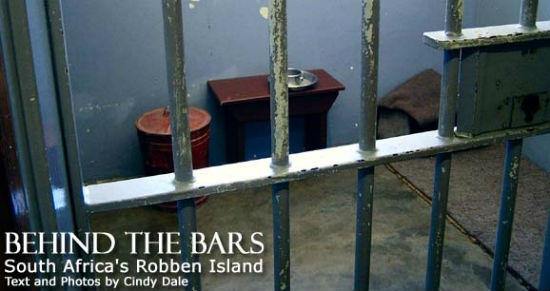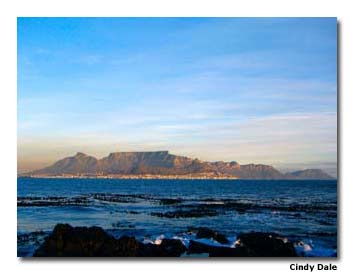

In the deep blue of Cape Town’s Table Bay Harbour lies an abiding symbol of colonial tyranny, the infamous icon of segregation, the Alcatraz-style Maximum Security Prison of Robben Island.
Since the early 1600s, Robben Island (Dutch for “Seal Island”), 7.5 miles (12 km) from the mainland and encompassing some 1,420 acres (5.7 km²), has served as a site of desolate banishment, exile and isolation to leprosy sufferers, mentally ill patients and political dissidents.
During South Africa’s apartheid era, political troublemakers and opponents of the regime were kept here. The apartheid system, which was based on racial segregation and supremacy of the white minority, officially ended with the first all-race democratic elections in 1994, when Nelson Mandela became the country’s first black president.
The most famous person in the struggle against the apartheid system, Mandela himself had been a political prisoner for 27 years. Much of this time was spent in a cell on Robben Island. In 1964 he was sentenced to life imprisonment for being a member of the then-banned African National Congress (ANC) and for acts of sabotage against the state. Mandela was released from jail in 1990.
The last political prisoners left the island in 1991 and the prison finally closed down. Today the island and prison are preserved as a museum whose guides are all former inmates. They provide valuable insight into the harsh treatment the former apartheid government employed to control rebels.
Cold reality sets in while thrashing through the choppy swells on the 40-minute ferry journey to the low-lying rocky outcropping, and watching the mainland shrink away. One can only imagine the realizations of former prisoners that there would be no escape from the foreboding loneliness that awaited them. No matter which way your political views swing, a visit to Robben Island is a deeply felt and emotional experience.
The island was proclaimed a World Heritage site in 1999, and guided tours run daily, on the hour, between 9 a.m. and 2 p.m., starting at the Mandela Gateway — the embarkation point at Cape Town’s Victoria & Alfred Waterfront, an old harbor complex transformed into a recreational resort and exclusive shopping center.
A tour of the island includes a bus journey to visit its oldest sites: the lepers’ graveyard and the small Church of the Good Shepherd, generally known as the leper’s church, built by the lepers themselves in 1864. We visited the lime quarry where those sentenced to hard labor cut blocks for those inside the prison to break into stones.
There’s the guard’s village, now home to the former prisoners-turned-guides, and nearby is a small cottage where Robert Mangaliso Sobukwe, the founder of the Pan Africanist Congress (PAC), passed his last days. The PAC was a liberation movement that transformed itself into a minor political party.
The former inmates accompanying each tour group give a first-hand account of what it was like to be incarcerated there. One such guide is Lionel Davis, who, in April 1964, was sentenced to six years on Robben Island, after being found guilty of conspiring to commit sabotage. Now Lionel lives on the island with his family, and is the chairperson of the Robben Island Village Association.
“During the day,” Lionel said, “prisoners were forced to endure hours of hard labor. This resulted in painful blisters forming on our hands, making the work a double nightmare. No first-aid kits were provided; we had to apply urine to our wounds to sterilize them.” He contemplated the horizon for a moment then continued.
“We were made to do pointless jobs, like spending three weeks digging a mountain of sand in one place, moving it to another place, and then transporting it back to its original position.”
After the Dutch captured the cape from the British in 1795 and then again in 1806, they used Robben Island as a prison for mostly white military prisoners and mostly black criminals. About a tenth of the prisoners were women, who were transferred to a Cape Town prison in 1835.
When Robben Island established a General Infirmary, from 1846 to 1931, becoming the main leper colony in the cape, with more than a thousand inmates, it was recorded that the “misfits” were treated with no respect whatsoever. They were cut off from society, banned from luxuries and scarred with insults.
Robben Island was meant to “cure” the lepers, as sea bathing improved their skin-condition, but, instead, the only treatment they received was hostility.
“Lepers were left on the island as people who are dead,” said Lionel. “Their food was poorly prepared and their clothes inadequate.” Lionel explained that men and women were not allowed to communicate with one another, as it was feared they would conceive leper children.
When the island became a maximum-security prison for political prisoners sentenced by the apartheid regime in 1959, the ordeals worsened, and racist wardens dominated the cold halls. Lionel shook his head, as if disbelieving his own recollections.

“They were abrupt, sour and cruel, their actions brutal and bloody. The prisoners were isolated from family — visits were seldom allowed, and when they were, they were strictly monitored.”
A tour of the prison is deeply disturbing. Our guide explained that he was open to questions but, understandably, there were some subjects on which he preferred not to comment and questions he chose not to answer. Inevitably, there was some lasting bitterness. The prison was cold, dull and undeniably hostile. Some prisoners would fake stomach ulcers, in order to be sent to the mainland hospital for treatment. They longed to view the “color” of the city. Others would be sent over to work.
“But when we were sent to Cape Town for the day, to do hard labor, we were thrown off the ferry upon arrival.” To prove his point, Lionel showed us the scars on his hands and knees, then recalled how the stench of sweat, feces and urine dominated the air on the ferry crossing. Clearly those painful memories still haunted Lionel. His granite eyes betrayed him on one occasion, and he averted his gaze, taking a moment to recompose himself.
Work on the island was hot and exhausting, and men labored all day in the quarries. The pale limestone wall reflected the glaring sunlight into the eyes of the prisoners, in some cases causing blindness. The wardens paced, hurling insults and whipping lazy prisoners.
The last highlight, and the reason everyone came, was to see the famed Mandela cell, which was identical to a hundred others.
I lingered a while and contemplated the “broom closet” that had been Mandela’s quarters. Gray walls, steel bars on the tiny window some eight feet (2.4 m) above the floor, a flimsy steel-frame bed, a thin, dirty mattress and a single blanket.
I quietly contemplated the difference between freedom fighters and terrorists, then asked Lionel why exactly Mandela had been imprisoned. His response was vague and dismissive. How quickly the world forgets, I thought.
Lionel spoke calmly of his former jailers and the appalling conditions he and fellow inmates had to endure. He brought to life a South African heritage which speaks of man’s valiant stamina in the face of hardship, and the prevailing human spirit.
The tour finished on an upbeat note as Lionel explained that while Robben Island has a terrible and desperately sad history, the imprisoned freedom fighters succeeded in their demands, and now manage South Africa’s future. There is a photo display of subsequent reunions of prisoners who are now political leaders.
The message I left with was one of victory over oppression, triumph over inequality, but most of all, the dignity of a modern democracy.
If You Go
Ferries depart between 9 a.m. and 2 p.m. from the Clock Tower, Nelson Mandela Gateway at Victoria & Alfred Waterfront. Book at least 24 hours before your proposed visit via the Cape Town Tourism Information Office.
The three and a half hour tour includes a return trip across Table Bay, a visit to the Maximum Security Prison, interaction with an ex-political prisoner and a 45-minute bus tour with a guide providing commentary.
Robben Island Museum
www.robben-island.org.za
Cape Town Tourism
www.tourismcapetown.co.za
South African Tourism
www.southafrica.net
- How to Get Around in Sydney: A Local’s Guide to Traveling Around Sydney - April 24, 2024
- The Low-Key Magic of Ghent, Belgium - April 22, 2024
- Discover the Hidden Charm of Extremadura in Spain - April 20, 2024
